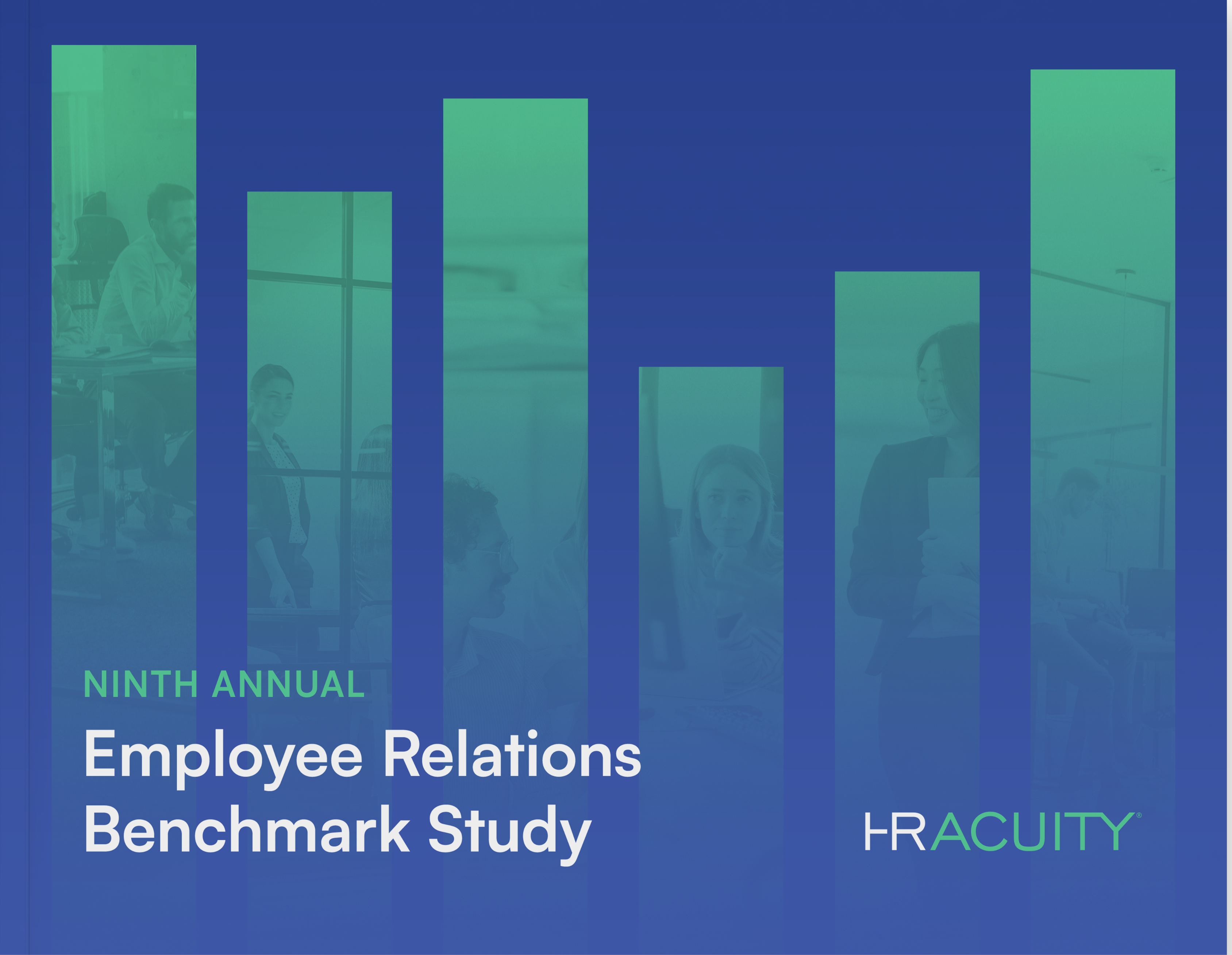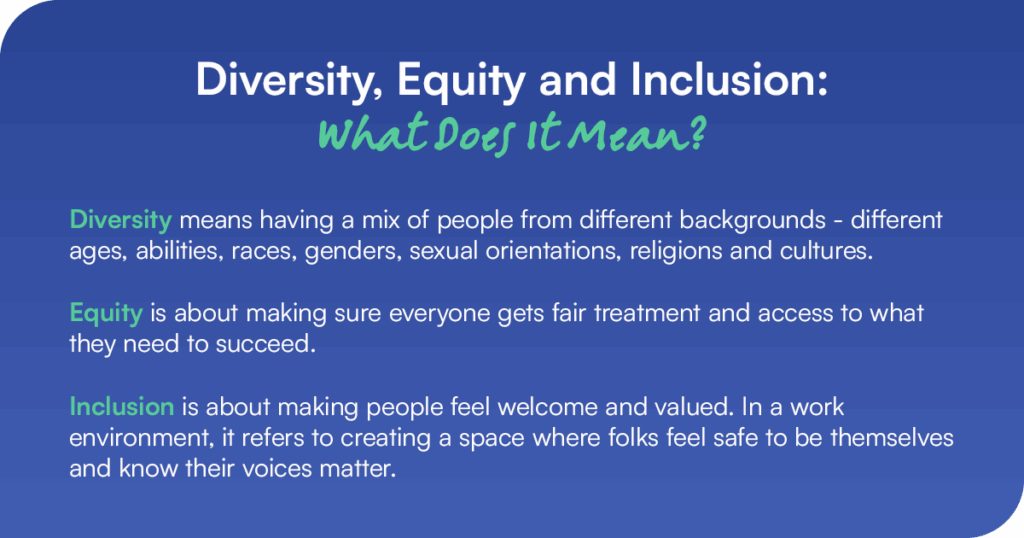As an employer, it’s your duty to create a workplace where your team feels psychologically safe every day. One of the most effective ways to do that? Invest in DEI.
No matter what the headlines say, DEI isn’t dead. In fact, it’s more important now than ever. If you’re serious about building a strong, inclusive culture, it’s always the right time to explore how to promote diversity, equity and inclusion in the workplace.
Not sure where to start? You’re not alone. We’re here to help you identify ways to promote DEI in the workplace that actually work—and drive meaningful change.
Whether you’re focused on improving DEI in the workplace, wondering how to improve DEI in the workplace or even asking, “Does DEI actually work?” The answer is a resounding yes, and we’ll show you how.

Why is Improving DEI in the Workplace So Important?
Historically, workplaces have been dominated by individuals with societal privilege—namely, white, cisgender, able-bodied, heterosexual men. Marginalized groups have had to fight for decades just to gain access to spaces that white men have dominantly occupied, such as office jobs.
Despite progress, including landmark legislation like the Civil Rights Act of 1964, systemic discrimination and barriers to entry persist. For example, in 2024, the Pew Research Center reported that in 2024, women earned an average of 85% of what men earned. That’s only a 4% improvement from 2003’s 81%, a dishearteningly slow pace of change.
Meanwhile, there is still no federal legislation prohibiting employers from discriminating against natural hairstyles. As of April 2025, 25 states have passed the CROWN Act.
Additionally, people with disabilities continue to face disparities in employment. In April 2025, the unemployment rate for people with a disability was 8.2%, compared to just 3.6% for those without one. That’s more than double.
To make matters worse, the current administration has been openly critical of diversity, equity and inclusion (DEI) initiatives. In an unprecedented move, President Trump removed two Democratic EEOC commissioners, Charlotte Burrows and Jocelyn Samuels, in January 2025. This marked the first time in the EEOC’s 61-year history that a president dismissed commissioners before their terms ended.
In short, we still have a long way to go. Employers have a responsibility to acknowledge that systemic workplace discrimination is a reality for many people. Most importantly, employers must commit to fostering an inclusive, equitable work environment where their entire team can thrive.
An Overview of Diversity, Equity and Inclusion in the Workplace
Diversity, equity, and inclusion (DEI) is a framework focused on creating fair and respectful environments where all individuals—regardless of their background—have equal access to opportunities and resources.
In the workplace, this can look like:
- Ensuring equal opportunities for people of all racial and ethnic backgrounds, including fair hiring, pay and promotion.
- Providing accessible work environments and accommodations for people with disabilities, like adaptive technologies or flexible working arrangements.
- Supporting religious inclusion, such as offering flexible break times or dedicated spaces for prayer and reflection.
- Hiring, retaining and promoting people from a wide range of life experiences—not just individuals who fit traditional molds of privilege.
Even though DEI is usually talked about as one idea, it’s made up of three different but interconnected parts. (Hint: If you want to learn how to improve DEI in the workplace, focus on all these facets!)
- Diversity means having a mix of people from different backgrounds — different ages, abilities, races, genders, sexual orientations, religions and cultures.
- Equity is about making sure everyone gets fair treatment and access to what they need to succeed.
- Inclusion is about making people feel welcome and valued. In a work environment, it refers to creating a space where folks feel safe to be themselves and know their voices matter.

Why DEI Initiatives Fail
When figuring out how to improve DEI in the workplace, it’s just as important to know what not to do. Too often, DEI initiatives fall flat—not because the concept is flawed, but because the execution is. That’s when people start asking, “Does DEI actually work?” (Spoiler: yes, it does—when it’s done with intention.)
Lack of Knowledge
It’s okay if you don’t know everything about DEI—it’s a constantly evolving framework and staying open to learning is part of doing it right. But that also means you’ve got to do your due diligence.
DEI initiatives often fall flat or come off as totally tone-deaf when HR and ER teams don’t do their homework. Start by digging into academic research to understand the foundations of DEI work.
Another pro tip: Talk to advocacy groups. They can help you understand how systemic discrimination shows up in the workplace. Without that insight, you won’t be able to address the root causes or drive real, meaningful change.
Take Intersectional Discrimination into Account
Often, employees face multiple instances of discrimination. For instance, Black women can experience both sexism and racism at work. This is called “misogynoir.”
To really make an impact with your DEI efforts, it’s imperative you consider the different forms of prejudice your team may encounter. Employees’ identities should be viewed holistically.
Token Hires
The only thing worse than having no DEI efforts at all is putting them in place just to feel good about it—or worse, to appear inclusive without being inclusive. That’s called performative DEI, and one of the biggest red flags is tokenism.
Tokenism happens when companies hire people from underrepresented backgrounds but don’t take real steps to make sure they’re included, supported or valued. For example, your company might employ many women-identifying people but not have a single woman in the C-suite. If the alarm isn’t sounding yet, it should be—this is textbook performative DEI.
This kind of surface-level approach doesn’t fix systemic issues—it just puts a band aid over them. If you’re serious about change, you’ll need to dig deeper.
Start by running an inclusion survey to understand how your team really feels. But keep this in mind: employees in senior positions tend to report feeling more included than those in junior roles, which can skew your data. A 2022 global study by the International Labour Organization found that 92% of senior-level employees felt included, compared to 83% overall.
Evaluate Your Organization’s Current DEI Position
Now that you know what not to do, we’re almost ready to share what you should. But before you jump into implementing DEI in the workplace, let’s discuss how to take stock of where you’re already at.
Before we dive in, a word to the wise: DEI is a long-term process. You won’t be able to implement a one-size-fits-all strategy that works instantly. It’s important to revisit your approach regularly to make sure you’re evolving.

Survey Your Team
If you want to understand how inclusive your workplace really is, start by asking the people experiencing it every day: your team.
Send out a mandatory survey that asks:
- How included do you feel at work?
- What current DEI efforts feel effective?
- Where do you think we’re falling short?
Tip: Make sure responses are anonymous. People may be hesitant to share honest feedback out of fear of retaliation.
Review Company Demographics
Take a hard look at who makes up your team. Are certain groups overrepresented while others are noticeably absent?
If your workforce is overwhelmingly homogenous, it’s time to rethink how you’re recruiting—and retaining—talent.
- Who are you hiring?
- Who gets promoted?
- What about leadership? (More on that later.)
Tip: Talk to your recruiting team about setting more inclusive hiring goals. Consider strategies like blind recruiting, where names and demographic details are removed from resumes during initial reviews to reduce unconscious bias.
Dig Into Financial Data
Look at how much your company actually invested in DEI over the last year. If your budget is nonexistent—or barely there—there’s work to be done. Money isn’t everything, but it does tell a story. If DEI matters to your organization, your budget should reflect that.
Tip: Even if you’ve spent money on DEI, assess whether those efforts were meaningful or just performative. Spending doesn’t necessarily correlate with impact.
Audit Your Programming
What kinds of DEI-related training or programming have you run? If you haven’t done things like unconscious bias training, or if your team isn’t educated on laws like the CROWN Act, you may be missing the mark.
Tip: Let employees tell you what they want to learn. On your survey, provide a list of potential training topics and offer a space for people to suggest their own. This helps address gaps people might feel too uncomfortable to speak up about.
Consider Senior Leadership
If your leadership team lacks diversity, you risk falling into the tokenism trap. Representation at the top matters.
Take a close look at:
- Who’s in leadership roles?
- Are underrepresented employees given real opportunities to grow?
- Is leadership modeling inclusive behavior?
Tip: DEI shouldn’t just live in HR—it needs real buy-in from senior leaders who are actively involved and held accountable for results. Leadership sets the tone for the entire organization.
Resistance to DEI
If you’re doing all the right things and still feel like DEI is not working, it might be time to ask a tough question: Are there people on your team actively pushing back against your progress?
The truth is, not everyone will support your organization’s commitment to diversity, equity and inclusion. Some employees might feel threatened by efforts to create equity for underrepresented groups. They may wrongly believe that lifting others up means taking something away from them.
Worse, some employees may reveal themselves to be outright homophobic, transphobic, sexist or racist. You’ll need disciplinary policies in place to deal with such situations.
How to Improve and Promote DEI
Improving diversity, equity and inclusion in the workplace requires time and commitment, but it’s incredibly worthwhile. Here’s how to begin.
1. Make Sure Leadership is On Board
Let’s be honest: improving your DEI efforts is impossible without leadership support. That’s why securing leadership buy-in should be your top priority from the very beginning.
In some cases, leadership may already be deeply invested in DEI and understand its importance—if so, you’re ahead of the game. But even more critically, if your leadership doesn’t believe in the need for a more inclusive workplace—or fails to model that belief—progress will be limited, no matter how hard the rest of the team works.
Pro Tip: Take a cue from HubSpot and consider implementing an annual DEI report issued by leadership. This report should transparently outline both successes and areas for improvement, helping to build trust and ensure accountability. The annual DEI report includes information on leadership demographics, progress updates and clear goals that hold leadership accountable.
2. Foster Open Communication
So, your leaders are bought in. Now what?
Next, encourage open and honest conversations about the topic. These discussions may not always be easy, but it’s necessary to build an environment where employees feel safe expressing their thoughts in a respectful and constructive manner.
Pro Tip: Consider creating an equity alliance or a similar group within your organization. This group can serve as a dedicated space for dialogue and support.
3. Hire Intentionally
Building a diverse team begins with being deliberate in how (and where) you hire. Intentional hiring leads to stronger collaboration, smarter decision-making and better outcomes across the board. (Want to learn even more about DEI benefits? We’ve got you covered.)
Here’s how to put it into practice:
- Use blind resume screening to reduce unconscious bias in early review stages.
- Diversify your interview panels to ensure multiple perspectives shape hiring decisions.
- Expand your recruitment reach to include HBCUs, community organizations and professional groups focused on underrepresented talent.
Pro Tip: Start by giving your current hiring practices an audit. Once you’ve identified gaps, you’re a step in the right direction toward diversifying your talent pipeline.
4. Onboarding that Prioritizes DEI
Hiring someone is just the beginning. If DEI matters to your organization, it needs to show up in onboarding.
Here’s how:
- Introduce Employee Resource Groups (ERGs) and let people know how to get involved
- Host a DEI session to walk through key initiatives and values
- Make DEI training part of onboarding, not optional
- Offer real support—things like assistive tech, flexible schedules or remote options for those who need them
Pro Tip: Don’t wait for day one. Send a welcome email that includes your DEI statement and key resources, so people know what you stand for upfront.
5. Implement Employee Resource Groups (ERGs)
ERGs offer underrepresented team members a place to connect, feel seen and build community at work. They’re also a powerful way to show your company values lived experience, not just surface-level diversity.
ERGs can focus on many identities, including:
- Black employees
- Women
- LGBTQ+ team members
- People of Color
- Employees with disabilities
- And others based on your team’s needs.
Pro Tip: Wondering where allies fit into the picture? ERGs also provide opportunities for allies to show up and listen to the conversation to hear about their colleagues’ lived experiences that are different than their own.
6. Offer Mentorship Opportunities
Mentorship isn’t just about career growth—it’s a DEI accelerator. It opens doors, builds confidence, and levels the playing field for team members from underrepresented groups.
Pro Tip: Get leadership involved. Even if they can’t commit long-term, ask them to set aside an hour each month for informal mentoring. A simple sign-up sheet can go a long way in making them more accessible and showing that development matters at every level.
7. Provide Training Opportunities
No one is expected to know everything about DEI—but everyone should be expected to learn. Offering ongoing training shows your team that growth and accountability matter.
Training helps build awareness, shift mindsets and create shared language around inclusion. It also reinforces that DEI isn’t optional—it’s part of how your team works.
Pro Tip: Start with unconscious bias training, then build from there. Consider offering deeper, long-term learning opportunities and make DEI training a regular part of your calendar, not a one-off.
8. Create Policies that Support Folks
Sometimes, company policies—without meaning to—can disproportionately impact people from underrepresented groups. The solution is to implement policies that support everyone, with flexibility and equity at the center.
For example, remote or hybrid work might be essential for employees with disabilities or neurodiverse team members. Flexible schedules can help caregivers or those managing mental health. The goal is to create systems that don’t just work for the majority but truly support every team member.
Here are some of our favorite inclusive work policies:
- Flexible paid time off
- Remote or hybrid work options
- Mental health support through healthcare plans
- Inclusive parental leave for all family structures
- Floating holidays for religious or cultural observances
- Learning stipends for financial wellness, career growth or DEI education
- Clear, transparent accommodation processes for people with disabilities
- Gender-affirming healthcare coverage
- Give folks time off to vote or to attend a protest
Another important supportive policy is offering an anonymous reporting hotline. This gives employees a safe way to speak up about concerns, especially if they’re worried about retaliation or being identified.
In fact, 72% of employees say they feel more comfortable raising issues through an anonymous channel. If you’re serious about creating psychological safety, this is a great place to start.
Pro Tip: Don’t assume what your team needs—ask. Regularly review policies and invite employee feedback to make sure your benefits reflect the people who work for you.
9. Set Goals and Track Them
To know whether your DEI efforts are working, you need measurable goals. Tracking progress helps you stay accountable and adjust strategies when needed.
For example, you might:
- Monitor the number of DEI or discrimination-related cases reported over time
- Use employee surveys to evaluate the impact of specific trainings or initiatives
- Set targets for how many DEI trainings or discussions you want to host annually
Pro Tip: Employee relations software can make tracking easier and more efficient. Instead of hunting down data across platforms, you can access key metrics in one place—making it easier to stay on top of your goals.
10. Hold Your Team Accountable
At the end of each year, report back on your DEI goals. Be honest about what worked, what didn’t and what you’re still working on. This builds trust, keeps senior leaders accountable and reminds your team that DEI is a real priority.
Strong communication matters. If people don’t know what’s happening, they can’t engage with it. Make it easy to understand where you’re headed and why it matters.
Once your review is done, share it: Internally with your team and leadership, and externally with investors or other key stakeholders.
Pro Tip: Use this as a chance to gather feedback. While you should be checking in after each session or initiative, a year-end anonymous survey helps you take stock of the big picture—what landed, what didn’t and where people want to see more focus
11. Continue to Iterate
Your DEI efforts should never stagnate. To keep them effective, continuously evolve your initiatives. One of the best ways to do that is to regularly gather feedback from your team.
Pro Tip: In addition to scheduled surveys, set up an anonymous suggestion form so employees can share feedback confidentially at any time. This ensures you’re capturing input in between survey cycles and staying in the loop about emerging needs.
Improve DEI with HR Acuity
The core of DEI is about making workplaces a space “for all” rather than “for some.” Not only does improved DEI benefit employees on a personal level, but it also works to the advantage of organizations and ensures their continued success in a world that is becoming ever more competitive regardless of industry.
With HR Acuity’s vast array of employee management software, your organization can improve the entire employee experience. Our intelligent data-powered offerings are designed to help you manage your employees in a way that is scalable, effective and sustainable. By using software that identifies, investigates and tracks employee issues, your organization can spot and address potential DEI issues quickly and efficiently. Get a demo today to discover how we can help support your DEI initiatives.




